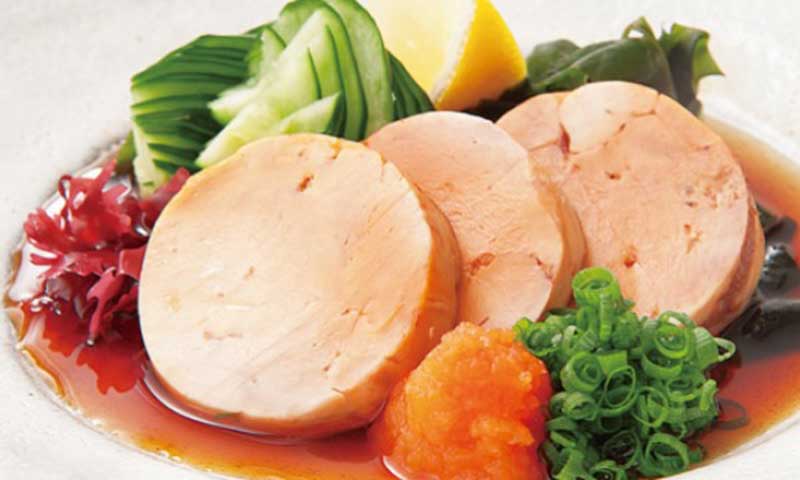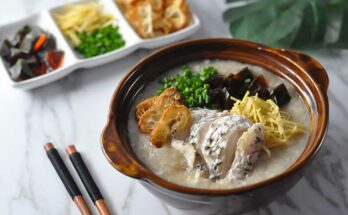In this article, we will guide you through a simple and easy-to-follow ankimo recipe, allowing you to indulge in the flavors of Japan from the comfort of your own kitchen. Discover the art of preparing this traditional Japanese delicacy with our homemade ankimo recipe, and impress your family and friends with your culinary skills.
Ankimo is a popular Japanese appetizer made from the liver of the monkfish. Known as the “foie gras of the sea,” it is a delicacy that captures the essence of traditional Japanese cuisine. Our ankimo recipe will help you recreate the rich and delicate flavors of this exquisite dish, and experience the true taste of Japan.
Key Takeaways:
- Ankimo is a traditional Japanese dish made from monkfish liver.
- Our homemade ankimo recipe allows you to enjoy this delicacy at home.
- Ankimo is revered for its rich and delicate flavors, earning it the nickname “foie gras of the sea.”
- Follow our step-by-step guide to create a tasty ankimo appetizer.
- Personalize your ankimo recipe with our tips and variations for enhanced flavors.
What is Ankimo?
Before we delve into the ankimo recipe, let’s understand what ankimo is.
Ankimo is a popular Japanese appetizer made from the liver of the monkfish. Known as the “foie gras of the sea,” ankimo has a rich and delicate flavor that is savored by food enthusiasts. It is often served as a delicacy in traditional Japanese cuisine and is a favorite among sushi connoisseurs.
The monkfish liver, the star ingredient of ankimo, is prized for its creamy and velvety texture. It is often compared to foie gras in terms of its taste and richness. However, what makes ankimo unique is its distinct umami flavor, which adds a touch of sophistication to any dish.
Furthermore, this Japanese appetizer is not only delicious but also highly nutritious. Monkfish liver is a good source of omega-3 fatty acids, vitamin A, and iron, making ankimo a healthy choice for seafood lovers.
With our homemade ankimo recipe, you can recreate this delectable dish in the comfort of your home. Whether you’re a fan of Japanese cuisine or simply looking to explore new flavors, ankimo is a must-try appetizer that will leave you wanting more.
How to Make Ankimo: Step-by-Step Guide
Now, let’s dive into the step-by-step process of making ankimo. With our best ankimo recipe, you’ll be able to prepare this traditional Japanese dish with ease. Follow these simple instructions to create a delicious appetizer that will impress your family and friends.
-
Ingredients:
- Fresh monkfish liver
- Salt
- Sake (Japanese rice wine)
- Kombu (dried kelp)
-
Step 1: Preparing the Monkfish Liver
Start by cleaning the monkfish liver. Remove any membranes or blood vessels, ensuring only the liver remains.
-
Step 2: Seasoning the Liver
Sprinkle salt generously over the monkfish liver and let it sit for about 30 minutes. This will help draw out any excess moisture and enhance the flavors.
-
Step 3: Steaming the Liver
In a steamer, place a sheet of kombu and lay the seasoned monkfish liver on top. Sprinkle some sake over the liver. Steam the liver for approximately 20 minutes or until it turns firm and easily separates.
-
Step 4: Cooling and Slicing
Once steamed, allow the liver to cool to room temperature. Carefully slice the liver into thin pieces, about 1/4 inch thick.
-
Step 5: Serving
Arrange the sliced ankimo on a serving plate and garnish with a drizzle of ponzu sauce or grated daikon radish. Serve chilled and enjoy the rich, creamy flavors of ankimo.
Now that you have mastered the art of making ankimo, you can delight in this traditional Japanese dish whenever you desire.

Tips and Variations:
Here are some tips and variations to enhance your homemade ankimo recipe:
- Add a pinch of chili powder or wasabi to give your ankimo a spicy kick.
- Garnish with chopped green onions or shiso leaves for added freshness.
- Experiment with different types of sauces, such as yuzu sauce or soy sauce, to complement the flavors of ankimo.
- Try serving ankimo with toasted baguette slices or cucumber rounds for a unique twist.
With these variations, you can personalize your ankimo recipe and create a culinary masterpiece that suits your taste preferences.
Tasty Ankimo Recipe: Tips and Variations
Enhance the flavors of your ankimo with our expert tips and variations. In this section, we’ll share additional ways to make your tasty ankimo recipe even more delectable. Whether you prefer a spicy twist or want to experiment with different seasonings, we have suggestions to help you personalize your homemade ankimo.
1. Spice it Up
Add a kick to your ankimo by incorporating some heat. Sprinkle a pinch of cayenne pepper or red chili flakes over the dish before serving. The spicy undertones will elevate the flavors and add a tantalizing element to your homemade ankimo recipe.
2. Citrus Zest
Bring a burst of freshness to your ankimo by grating some citrus zest over the top. Whether it’s lemon, lime, or orange, the vibrant citrus flavors will complement the rich and creamy texture of the monkfish liver. This simple addition adds a delightful twist to the traditional ankimo recipe.
3. Soy Sauce Glaze
Elevate the umami flavors of your ankimo by drizzling a soy sauce glaze over the top. Mix equal parts soy sauce, mirin, and brown sugar in a saucepan and reduce it until it thickens slightly. Pour the glaze over the ankimo, allowing it to seep into the delicate crevices and enhance the overall taste.
4. Toasted Sesame Seeds
Add a nutty and aromatic touch to your ankimo by sprinkling toasted sesame seeds. Lightly toast the sesame seeds in a dry skillet until they turn golden brown and release their fragrance. The roasted seeds will bring a delightful crunch and depth of flavor to your homemade ankimo.
| Tips and Variations | Description |
|---|---|
| Spice it Up | Add a pinch of cayenne pepper or red chili flakes for a spicy twist. |
| Citrus Zest | Grate lemon, lime, or orange zest to bring a burst of freshness. |
| Soy Sauce Glaze | Drizzle a soy sauce, mirin, and brown sugar glaze to enhance the umami flavors. |
| Toasted Sesame Seeds | Sprinkle toasted sesame seeds for a nutty and aromatic touch. |
Experiment with these tantalizing variations to create a customized tasty ankimo recipe that suits your palate. The beauty of homemade ankimo lies not only in its traditional preparation but also in the freedom to add personal touches. Enjoy the process of exploring new flavors and making this Japanese delicacy uniquely your own.
Conclusion
Master the art of making ankimo with our simple steps and enjoy this traditional Japanese delicacy in the comfort of your own home. Our ankimo recipe captures the true essence of Japanese cuisine, allowing you to impress your guests with a delightful Japanese appetizer.
With its rich and delicate flavor, ankimo is the perfect addition to any gathering or special occasion. The homemade ankimo recipe we have shared in this article allows you to savor the authentic flavors of Japan and experience the true essence of this traditional dish.
By following our step-by-step guide, you can easily recreate this popular Japanese appetizer and indulge in its enticing taste. Whether you’re a fan of traditional Japanese dishes or looking to expand your culinary repertoire, ankimo is a must-try delicacy that will surely delight your taste buds.
Bring a taste of Japan to your table and elevate your dining experience with our ankimo recipe. Embrace the flavors of this exquisite Japanese dish and let it transport you to the vibrant streets of Japan. Unlock the culinary secrets of ankimo and enjoy its unique and tantalizing taste that has captivated food enthusiasts for generations.
FAQ
What is ankimo?
Ankimo is a popular Japanese appetizer made from the liver of the monkfish. It is often referred to as the “foie gras of the sea” due to its rich and delicate flavor.
What makes ankimo a traditional Japanese dish?
Ankimo has a long history in Japanese cuisine and is considered a traditional delicacy. It has been enjoyed in Japan for centuries and is commonly served in upscale restaurants and during special occasions.
Can I make ankimo at home?
Absolutely! With our homemade ankimo recipe, you can easily recreate this Japanese delicacy in your own kitchen. Just follow our step-by-step guide for a delicious result.
What is the best ankimo recipe?
Our recipe provides a simple and tasty method to make ankimo. However, personal preferences may vary, so feel free to experiment with different seasonings and techniques to find the recipe that suits your taste.
Are there any variations or tips for making ankimo?
Yes! In our “Tasty Ankimo Recipe: Tips and Variations” section, we provide additional suggestions to enhance the flavors of your ankimo. From spicy twists to unique seasonings, you can personalize your homemade ankimo based on your preferences.
Can I serve ankimo as an appetizer?
Absolutely! Ankimo is commonly served as an appetizer or starter in Japanese cuisine. Its rich and delicate flavor makes it a perfect choice to impress your guests before the main course.
How long does it take to make ankimo?
The preparation time for ankimo may vary, but on average, it takes about 24 hours to properly marinate the monkfish liver. The actual cooking time is relatively short, usually around 15-20 minutes.



